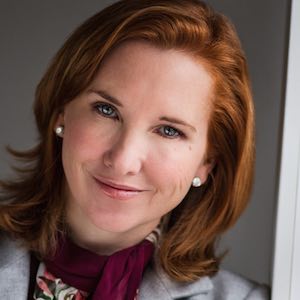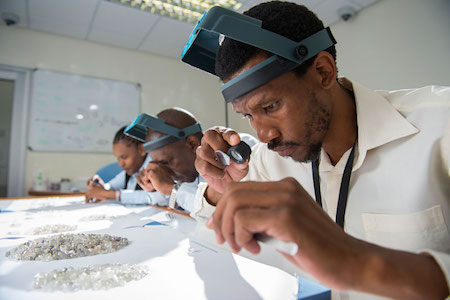
This week, Eira Thomas (pictured), CEO of Lucara Diamond, owner of the Karowe mine in Botswana, sent an open letter to the diamond industry promoting Clara, the sales perform that Lucara purchased two years ago.
Here, Thomas talks about how she feels Clara could change the industry’s current sales model, Lucara’s deal to sell all its special stones to HB Group, and her larger view of the COVID-era diamond market.
JCK: Why did you send that open letter out?
Eira Thomas: It was about building awareness. There have been a number of comments from Alrosa and De Beers and big players about the need to modernize and change things. For us, it’s about how we are already there.
I think there is some confusion about what it means to modernize our industry. There is the one approach about digitalizing the existing sales paradigm. That is not what Clara is. We are completely transforming how we sell diamonds. This is the only platform that you can buy diamonds individually based on specific demand. There is significant value that can be unlocked by creating a more efficient supply chain.
COVID-19 is advancing this at a much quicker pace. The restrictions that everyone is dealing with, we have necessitated new ways of transacting and Clara enables that. This assists at a time when there are some real limitations to move around the world. People can order diamonds from their home, akin to ordering espresso pods for their coffee maker.
How does Clara help value?
If you think about the way the world works, we sell our diamonds in rough assortments and then we create buckets or parcels that you intend to receive bids on, or in the case of De Beers, you have a sight. The manufacturers take those diamonds back to their factory and then they scan them.
Many of those manufacturers can only use a portion of the parcel of they bought. And that is a significant source of inefficiency. What Clara says is, let’s scan all the diamonds up front [to determine their polished yield]. So the manufacturers are not buying rough, they are buying polished. Those manufacturers are telling us what they want to make: “We want 10 1 ct. round stones at a certain price.” We now have a blueprint. Clara will search through the rough inventory and find the perfect rough stone for the manufacturer.
Everything is done in a black box. Nobody sees each other’s bids. Clara will find the highest value order for any given order, or any given stone, and allocate diamonds based on specific requests. The real beauty is nobody has to move out of their comfort zone. If you put up an order and don’t win anything, you can choose to just wait until a stone comes along that fits your criteria.
Traditionally, producers have sold in assortments, bundling “more attractive” diamonds with “less attractive” ones. Why is this a better model?
That’s been a big learning for me. We all have the same perception, that there are more desirable diamonds and less desirable diamonds. Diamonds do all get consumed. Eventually, they get traded to the right person that actually has a distribution point for those diamonds. What about getting those diamonds to that point in step one and not having to go through 10 trades? Get them to the person that is doing something with them and maximize the value. There is no such thing as an undesirable diamond on Clara.
When you look at an assortment, there will be maybe 20% that the manufacturer doesn’t need. So the manufacturer submits an average bid. They are never actually putting their best foot forward. The producer is never getting the strongest bid, they will get an average bid that reflects the ability of that person to sell all the diamonds.
Clara’s customers are bidding on their niche. That is why the producers get more money at the end of the day. You are selling the diamond to the right buyer.
It’s about creating a stable marketplace that links together the rough and polished markets in a much more sustainable way. Obviously, the polished market moves around, and manufacturers can adjust their bids at any point.
Does it cost more to ship, having to break up big orders into smaller ones?
There are some logistical costs. If you ship one stone, it does get expensive, but we don’t typically ship one stone. The goal is to get into continuous sales. Longer term, once we’ve built up enough supply, we are hoping to sell every two weeks.
How accurate is the platform as far as determining polished yield?
It’s very accurate. When we first started this, people would buy a few stones and then see how they did. Now, they just put them in the factory. You get comfortable with it pretty quickly when you are buying regular assortments. Some stones do better than you thought, some do worse. So we are still seeing variations, but we have found that variation is reduced and it’s become predictable.
As you know, there is something of a ripple effect in the industry, in that moves in polished demand tend to spark bigger up-and-down moves in rough demand. Does this help that?
That is what we’re really hoping for. We are tired of this boom and bust. We want a stable marketplace with reliable margins for all the participants. Let’s move away from a scenario where if the producers are doing well the manufacturers aren’t. Why can’t we create alignment for the entire chain?
The other thing is that Clara improves transparency. Everyone in the industry recognizes that provenance is more important. You can sort for Botswana or Canadian diamonds. You can say if you want fluorescence.
How has it helped you?
Pre-COVID, we were enjoying nice healthy margins, better than we were with tenders. What’s important to us is, not so much the margins, as we expect our margins to shrink longer term when more third-party production comes on the platform. We see selling third-party production as the real opportunity.
The intention is to open up Clara to the world. Our current supply on Clara is not meeting the demand. The demand is there. In the last six sales or so, we have been steadily improving. Now we are looking for supply.
There will also be an opportunity for Clara to handle secondhand goods, if they are qualified and certified and we know where they come from.
Have any third parties come on board yet?
We are in discussions. We have had two trials prior to COVID. Before the end of the year, we hope to add additional third-party production.
Are the big players interested?
We have talked to everyone. I can’t say who because of NDAs. COVID has made people concentrate on this.
Are you charging anything to use it?
We are not charging a fee to buy or sell on Clara. We are just establishing it. Clara makes money between the bid and the ask. At some point, we might charge a portion of that unlocked value. For now, we are not charging a fee. We’ll see how we go.
Do you ever see it having a consumer aspect?
Ultimately, maybe in version 8.0, we envision a day where a consumer will be sitting in their office and say, I’d like a diamond from Karowe. You’d have a bunch of pop-ups, maybe a manufacturer who is best suited to polish a stone of that nature or a designer allowing you to create your own piece of jewelry without leaving your desk. There are lots of ways that Clara can be customized for individual brands.

Two weeks ago, I wrote about Lucara’s deal with Antwerp’s HB Group to sell HB all of its special diamonds. I had some questions about how Lucara’s fee will be structured, whether it’s related to the ultimate polished.
We haven’t disclosed details on that. It will start to become a lot clearer once we get a few months down the road. It’s not easy to model. The fee, or commission, is tied to polished prices so we are both incentivized to maximize the value of the polished. It’s good alignment.
We have seen a lot less volatility in polished than we have in rough. These stones will achieve more in terms of revenues than if we tried to sell them just as rough.
Will HB be forced to take everything?
They do have to buy all of our rough [over 10.8 carats]. It’s not an option, and they are committed to it. We can revise that by the end of the year, but the idea is to get enough revenue to continue underground mining.
How do you see the market now?
It’s challenging, no question. People are trying to be optimistic and we feel the mood is getting better. We are pretty pleased to see our prices steadily improving. We certainly see diamonds and diamond jewelry as a luxury product that will continue to be in demand. People are focusing on their family. No one is spending money on travel. We are optimistic about the current holiday. We see some early encouraging signs.
(Photos courtesy of Lucara Diamond)
Follow JCK on Instagram: @jckmagazineFollow JCK on Twitter: @jckmagazine
Follow JCK on Facebook: @jckmagazine